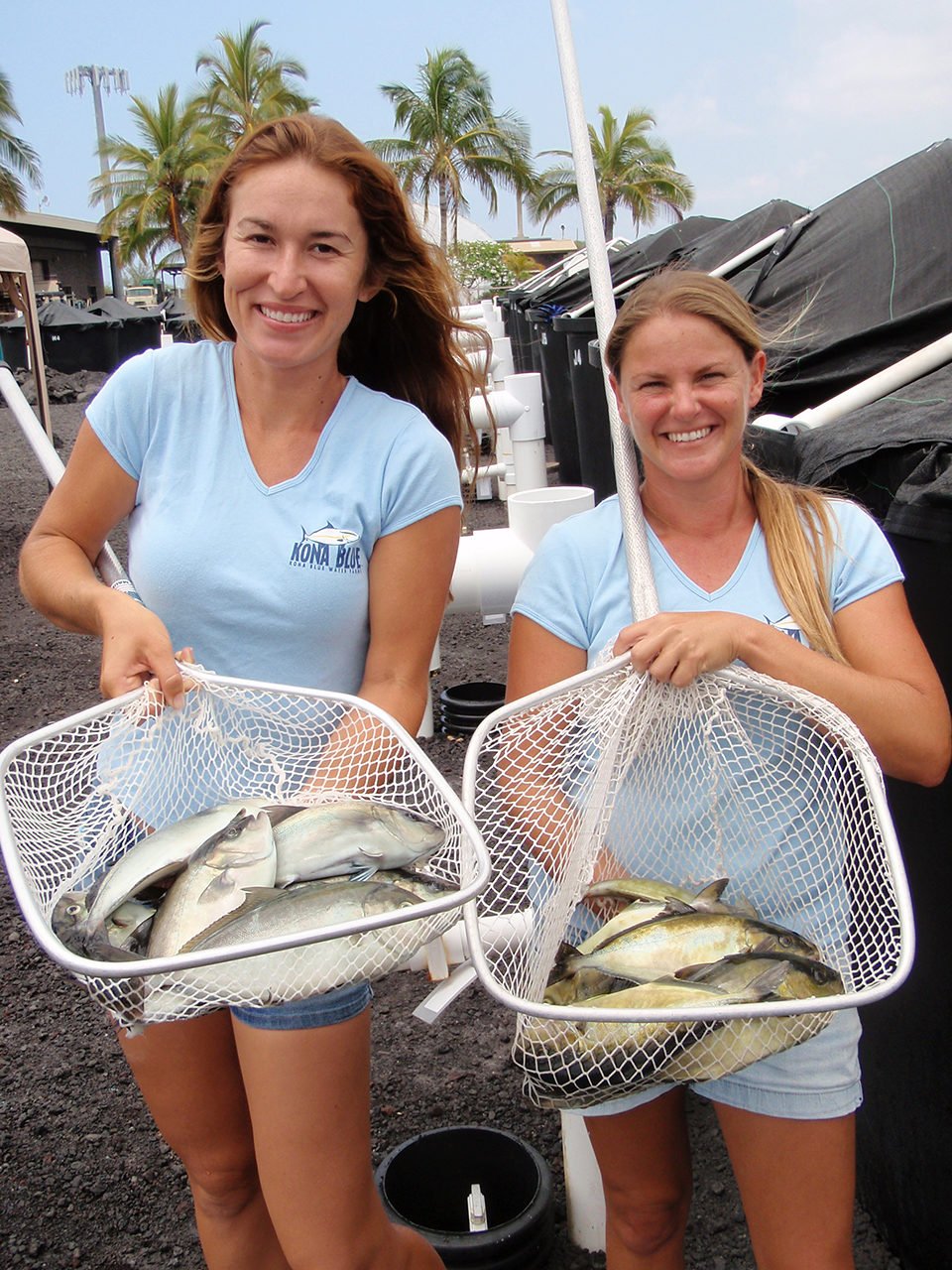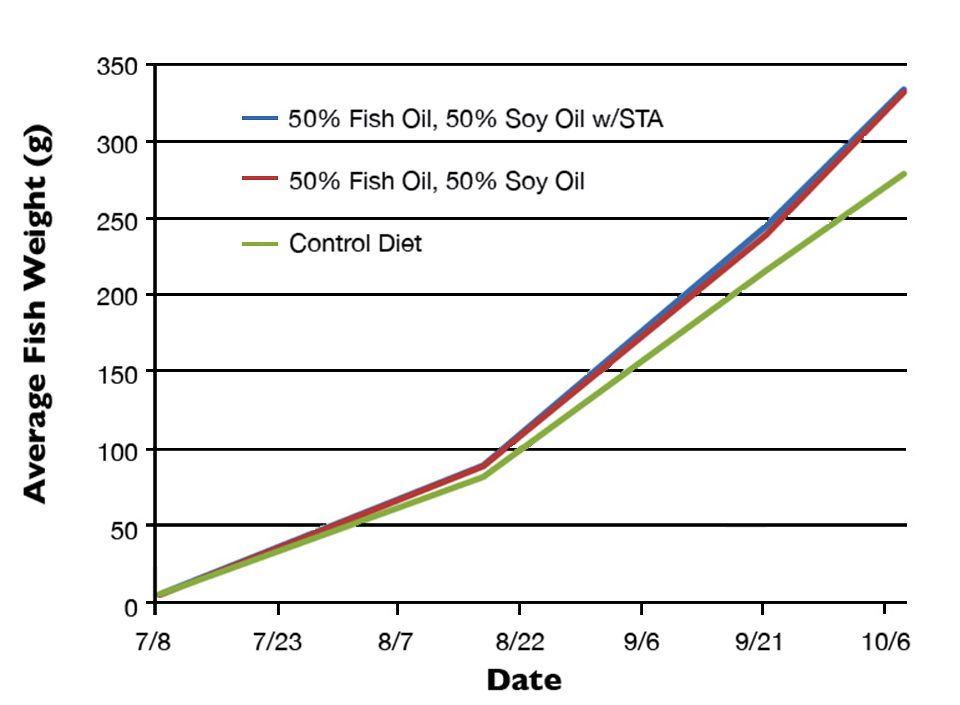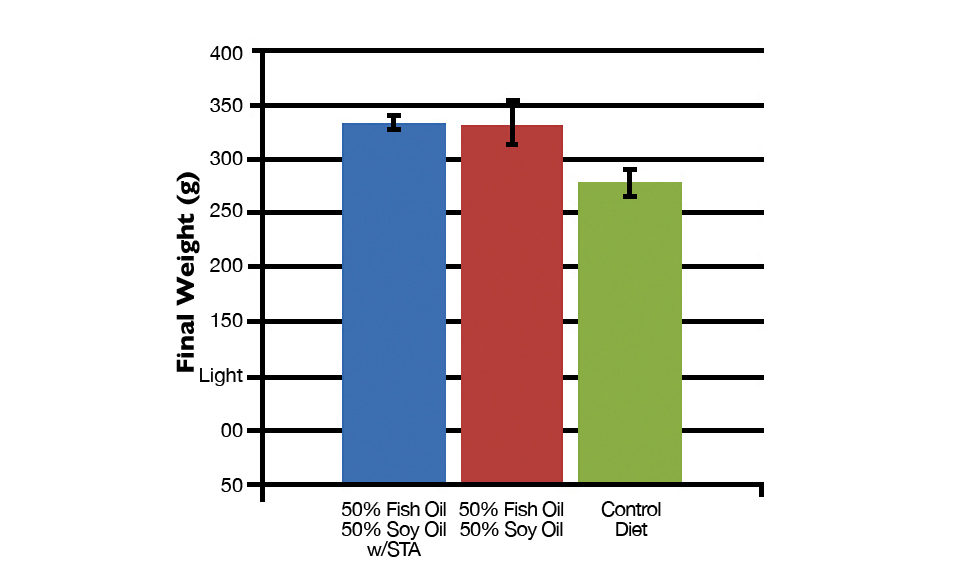Kona Blue trial shows species could result in no net loss of marine protein

Aquaculture’s requirements for fishmeal and fish oil are utilizing a large and increasing proportion of the world’s supplies. The marine finfish that are most highly esteemed for their taste and health benefits have the highest need for these marine-sourced proteins and oils. Their expanded production may be stymied by the fishes’ (assumed) biological needs for the fatty acids and amino acids found most abundantly and ideally in forage fish products.
Terrestrial agriculture producers have known for some time that specific fatty and amino acids need to be in animals’ diets. The sources of those proteins and oils, however, can be diverse. As stated in the recent United States Department of Agriculture/National Oceanic and Atmospheric Administration collaboration The Future of Aquafeeds: “Fishmeal and fish oil are not nutritionally required for fish to grow.”
In an effort to reduce the growing pressures on forage fisheries, Kona Blue Water Farms and the University of Nebraska have been pursuing research designed to maximize the levels of soy-based proteins and oils in the diets of longfin amberjack or “kahala” (Seriola rivoliana), known commercially as Kona Kampachi.
Nutrition research
Since 2007, there has been ongoing research to determine the ability of longfin amberjack to thrive on diets containing soy protein concentrate as a primary protein source. Additional work has examined this species’ ability to elongate the long-chain omega-3 fatty acid stearidonic acid (STA) into eicosapentaenoic acid (EPA), which could lead to a reduced need for fish oil in diets.
Early trials indicated not only an inability for the fish to elongate STA, but that the inclusion of soy concentrate in levels over 20 percent induced a severe reduction in growth and overall fish health. Following some encouraging studies by Japanese and North American researchers, the authors’ efforts were refocused on increasing soy concentrate inclusion, coupled with the non-essential amino acid taurine. By late 2008, fish reared on diets containing 40 percent soy protein concentrate with supplementary taurine performed as well as fish fed a commercially prepared diet used in longfin amberjack production.


Feeding trial
To confirm findings and assess which proteins and oils would be most applicable in future amberjack diets, a trial was conducted in 2009 examining three diets. Two contained soy protein concentrate with variations in lipid sources, and the third control diet was the standard commercial diet.
Forty percent of the experimental diets was soy protein concentrate, and another 10 percent was fishmeal, resulting in a feed that was 50 percent protein. This was around half the level of fishmeal used in the standard commercial diet. The lipids in the experimental diets were either a blend of 50 percent fish oil and 50 percent soybean oil high in STA or a blend of fish oil and standard soybean oil, yielding a lipid content of approximately 18 percent. Five percent taurine was included in the experimental diets.
Study setup
The trial took place from July to October 2010. The fish were held in 4,000-L round high-density polyethylene tanks at Kona Blue’s facility in Hawaii, USA, with three replicate tanks of each diet type. These tanks were supplied with flow-through, ambient temperature seawater filtered to 5 µ with an average flow rate of 40 L/minute. Tanks were aerated at all times.
Fish were randomly selected for each replicate, and the total biomass in each tank was recorded. The increases in total biomass, average fish weight and feed-conversion ratio were calculated. Initially, beginning when the animals were approximately 5 g in weight, the fish were fed three times daily to satiation. Once fish were greater than 100 g, the feeding schedule decreased to twice daily.
Tanks were cleaned daily, and uneaten food was collected and accounted for. Mortalities were removed and examined when found. Feed intake was recorded each day, and fish were weighed once every four weeks. Following the trial, fish tissue was analyzed to ascertain fatty acid content.
Results
There was virtually no difference in growth rates between the test diets, with increased mean weights of 329 grams and 328 grams over the three months. Fish reared on the control diet had a mean weight gain of only 274 grams.
The fatty acid profiles of the fish reflected the oils in the feed. Animals fed diets with increased levels of stearidonic acid had higher levels of alpha-linolenic acid and STA in their tissues, whereas fish fed diets with soybean oil had higher levels of linolenic acid in their tissues. The animals that ate the control diets had the highest amounts of EPA and docosahexaenoic acid. Feed-conversion ratios for all three diets were between 0.96 and 1.0.
Perspectives
These results suggested that there is great potential for increasing the sustainability of marine fish diets. The addition of supplementary taurine led to the doubling of the amount of soy protein concentrate that could be included in longfin amberjack diets.
The low fishmeal inclusion and low FCRs may in fact yield a wild fish in:farmed fish out (FIFO) ratio of less than 0.50, implying that this diet for this species could result in no net loss of marine protein. The fish oil levels resulted in FIFOs for the experimental diets of around 0.87. Ongoing work in 2011 will rear animals to market size and confirm the applicability of soy protein concentrate as a feed ingredient by culminating with a consumer taste test.
(Editor’s Note: This article was originally published in the July/August 2011 print edition of the Global Aquaculture Advocate.)
Authors
-
Jennica Lowell, M.S.
Kona Blue Water Farms
P. O. Box 4239
Kailua Kona, Hawaii 96745 USA[109,111,99,46,101,117,108,98,45,97,110,111,107,64,97,99,105,110,110,101,106]
-
Neil Anthony Sims, M.S.
Kona Blue Water Farms
P. O. Box 4239
Kailua Kona, Hawaii 96745 USA -
Tom Clemente, Ph.D.
University of Nebraska-Lincoln
Department of Horticulture and Agronomy
Lincoln, Nebraska, USA
Tagged With
Related Posts

Innovation & Investment
Mucosal mapping architect wins aquaculture innovation award
Quantidoc AS in Norway is the commercialization of Prof. Karin Pittman’s years of fish health research. Pittman, winner of this year’s Global Aquaculture Innovation and Leadership Award, utilizes stereology to measure and better understand mucous on gill, gut and skin tissues – the first line of defense for fish.

Innovation & Investment
Offshore aquaculture inches closer to reality in the Gulf of Mexico
New U.S. policies for offshore aquaculture permitting will soon be put to the test in the Gulf of Mexico. With imported products dominating the U.S. seafood landscape, some argue the time has come for the industry to take a leap forward.

Health & Welfare
Reporting of fish escapes, causes crucial step in developing better controls
Escapes of fish from farm facilities can lead to interbreeding and competition for mating opportunities with wild fish. Escapees may also transmit diseases and parasites, as well as compete for feed and space.

Innovation & Investment
SeaWeb Seafood Summit: Can impact investment ‘save’ aquaculture?
Impact investment, which seeks environmental and social returns in addition to profits, was examined during a SeaWeb Seafood Summit panel.


